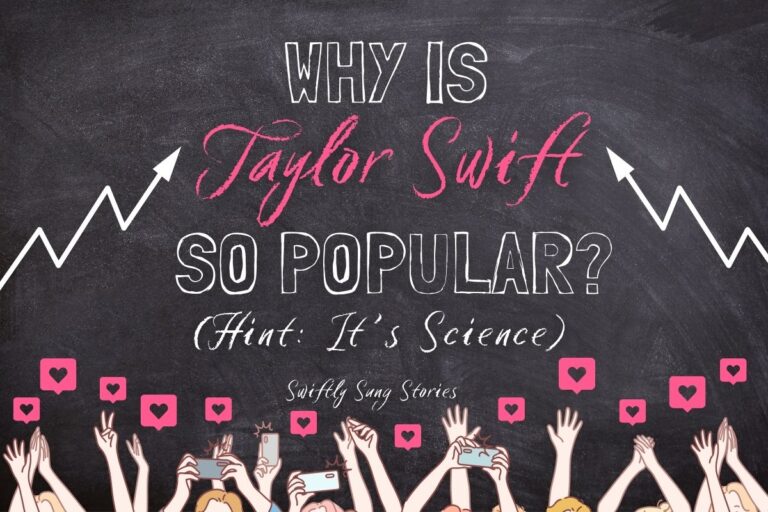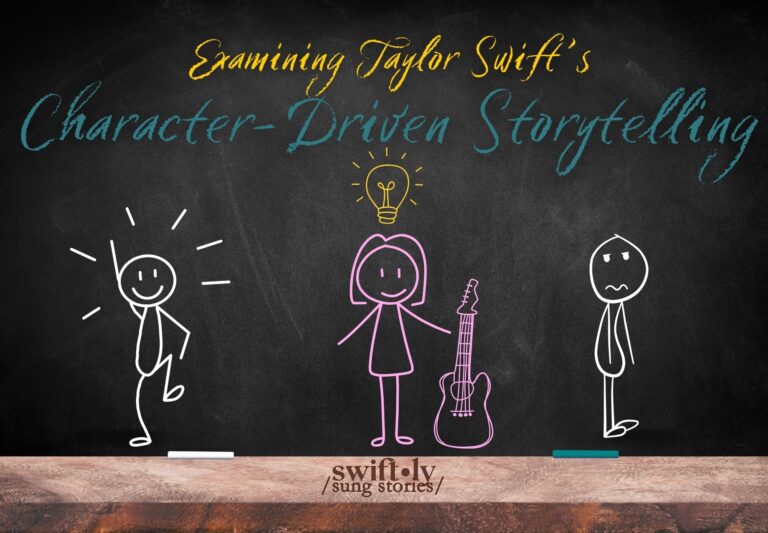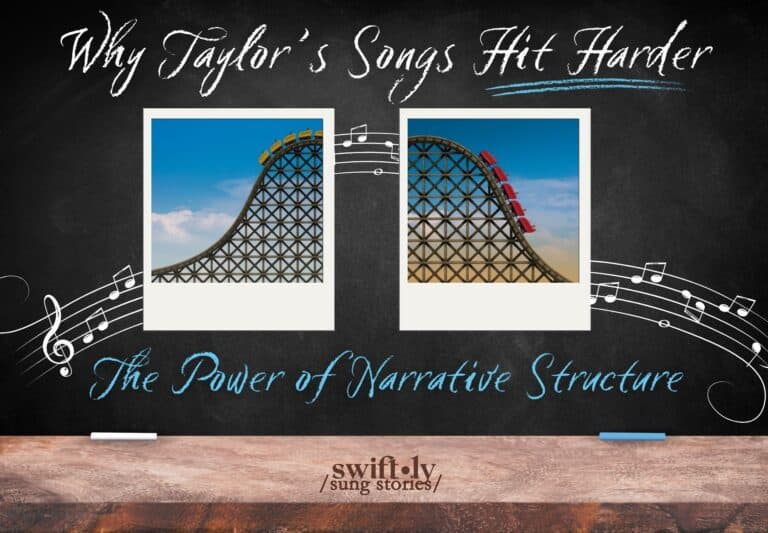Imagery, Metaphors & Symbolism: How Taylor Swift Builds Worlds
Why does Taylor Swift write about ghosts, blood, and mirrors? Why is her universe so vividly color-coded, with each hue representing a different emotion?
These aren’t just poetic flourishes – they’re part of a carefully crafted symbolic language.
Taylor Swift isn’t just writing lyrics; she’s building a world where every image carries weight. In her songwriting, red burns with passion, mirrors reflect hard truths, and ghosts linger with regret.
Her metaphors and symbols aren’t random: they’re carefully chosen devices that deepen her storytelling, and immerse us in the Taylor Swift universe.

But how does she use these literary devices so effectively? As your Swiftie English teacher, I’m here to break it all down for you.
Let’s unpack some of her most frequently used imagery, metaphors and symbols. We’ll discover why and how she uses them, and find out why these devices are so effective at leaving a lasting impression.
Quick Definitions: Imagery vs. Metaphor vs. Symbolism
Let’s recap some quick definitions that I covered in a previous lesson.

Imagery
Imagery is visually descriptive language that conjures an image in our minds.
- “The air is thick with loss and indecision” –You’re Losing Me
- “Your touch brought forth an incandescent glow” –ivy
Metaphor
A metaphor is a comparison, without using “like” or “as.”
‘You’re a rockstar’ is a metaphor for doing an impressive job, while ‘you’re like a rock’ is a simile.
- “I’m a crumpled up piece of paper lying here” in All Too Well compares her emotional state to a piece of trash, feeling carelessly discarded.
- “The rubies that I gave up” in Maroon are a metaphor for something valuable she sacrificed.
Symbolism
Symbolism is using an object, color, or image to represent a larger idea or emotion.
- In Tim McGraw, the country singer comes to symbolize the memory of their relationship, the good times they’ve spent together, and the love they share.
- In Red, the color symbolizes intense feelings of romance and infatuation.
- In Getaway Car, the car symbolizes serial monogamy: running away from a relationship by hopping straight into a new one.
Sometimes it’s tricky to distinguish a metaphor from a symbol, but for something to become symbolic, it usually needs to be used repeatedly, and used to represent a big idea or emotion.
A metaphor can become symbolic if it’s used again and again, but it’s usually more specific, and used to represent one thing and not a whole.
Got it? Good. Let’s dive into how Taylor uses metaphor, imagery, and symbolism in her writing.
Taylor’s Tailored Imagery
Taylor uses detailed imagery to draw us into the story, where we can see, touch, and feel what it’s like inside.
This helps her narratives come alive, and also allows us to connect to the central emotions she’s conveying. It appeals to all of our senses, and makes her writing memorable and accessible.
Here are some common forms of imagery Taylor uses, what they mean, and how they enhance her writing.

Nature Imagery 🍂
Taylor often uses imagery of trees, plants, water, and weather to enhance her stories. This ties her narratives to the natural world we all live in, making them more relatable, and also gives her writing a timeless quality.
- “I want to watch wisteria grow right over my bare feet” –the lakes. Conveys time moving slowly, carefree moments reflected by the bare feet, and helps us imagine this idyllic scene where we become part of the landscape.
- “The way you move is like a full-on rainstorm” –Sparks Fly. Reflects the subject’s unpredictable and torrential nature, and the threat that he can sweep her away (this is also a simile).
- “Long limbs and frozen swims, you’d always go past where our feet could touch” –marjorie. Helps us imagine this chilly swimming scene, where the subject’s long limbs are always out of reach.
Clothing Imagery 👠
Taylor commonly uses imagery of clothing, which helps to anchor her stories in our everyday world. We find it easy to imagine what her characters look like by her details of what they wear, and their clothing also gives us a sense of who they are.
- “Lilac short skirt, the one that fits me like skin” –imgonnagetyouback. Conveys the sexy, confident vibe of the speaker, getting ready to take revenge by ‘dressing to kill’.
- “When you think happiness, I hope you think that little black dress” –Tim McGraw. Associates a significant outfit with happy times they’ve spent together, and helps us imagine this young couple in love.
- “You got that long hair, slicked back, white t-shirt” –Style. Conveys the subject’s James Dean-like style, which helps us picture this bad boy character.
- “Vintage tee, brand new phone, high heels on cobblestones.” –cardigan. Contrasts new with old, representing this character’s past and present.
Driving, Road & Travel Imagery 🚦
Taylor uses transport imagery to help us imagine her characters moving from one emotional place to another.
The “road” often represents the road of life or a relationship, which can stay the course, or go off the rails and into the ditch.
- “Two headlights shine through the sleepless night” –Treacherous. The car’s headlights represent a guiding light, and we can imagine our character finding one another in a dark night of the soul.
- “I ask the traffic lights if it’ll be alright, they say ‘I don’t know’.” –Death by a Thousand Cuts. We imagine our speaker so desperate for a sign that she’ll be okay that she asks an inanimate object. Should she stop or should she go? Is she on the right path?
- “We’re singin’ in the car, gettin’ lost upstate.” –All Too Well. This moment of driving conveys the happier times on the “road” of their relationship, which will later crash into a ditch.
✏️ Exercise: Read the lyrics to I Bet You Think About Me. What imagery does Taylor use to characterize the male subject? What does it tell us about him?
Signature Swift Metaphors
If imagery is just describing how something looks, metaphors are describing how something is.
Part of why Taylor’s songwriting is so powerful comes down to her use of metaphors. She doesn’t just say ‘wow, you really blew it.’ Instead, she says, “I’m an Aston Martin you drove straight into a ditch”.
The latter conveys so much more than the former ever could. It tells us her innate value, like a luxury sports car, and how he carelessly used and discarded her. It tells us exactly how this situation felt: like being totaled, after never being handled with care in the first place.
Taylor uses metaphors very deliberately and tactfully, and as her career has grown, so have the power of her metaphors. However, one thing has remained constant since the beginning: she uses metaphors that double as emotional truth.
Let’s look at some examples of how this works.

Love as a Drug Metaphors 💊
Taylor often uses metaphors that describe love as a drug or an addiction. Falling in love is like taking a hit, while losing or missing someone feels like withdrawal.
- Blank Space: “You can tell me when it’s over if the high was worth the pain”.
- Don’t Blame Me: “My drug is my baby, I’ll be usin’ for the rest of my life.”
- Glitch: “I was supposed to sweat you out”.
- Florida!!!: “It’s one hell of a drug,” and “can I use you up?”
- The Alchemy: “He jokes that it’s heroin but this time with an ‘E’”
These metaphors “hit different” because they feel true of our experience of love and loss. We’ve all been infatuated with someone, where one glimpse of them makes your stomach flip.
We’ve also cried on bathroom floors after breakups, in “withdrawal” from the relationship, and craving just one more “hit.”
Relationships as a War ⚔️
Pat Benatar first said, “Love is a battlefield.” But Taylor takes it a step further, frequently using war and battle metaphors to describe difficulties in relationships.
- The Story of Us: “This is looking like a contest / of who can act like they care less / But I liked it better when you were on my side.”
- All Too Well: “I’m a soldier who’s returning half her weight.”
- Bad Blood: “Band-aids don’t fix bullet holes.”
- Epiphany: “With you, I serve / With you, I fall down, down”
- The Great War (the entire song is an extended metaphor): “Tore your banners down, took the battle underground”, “Your finger on my hair pin triggers”,”You drew up some good faith treaties”.
These metaphors are impactful because we can relate, and we can easily imagine a breakup as a war between two people. Sometimes it really feels like you’re in the trenches in life, either fighting alongside the ones you love, or fighting against them.
Light & Darkness as Emotional States 🌒
Taylor seems to have a color-coded index of what emotions feel like to her, and often uses these colors as metaphors for love. Darker colors reflect more somber emotions, while brighter colors represent happier times.
- Red: “Loving him was red,” “losing him was blue like I’ve never known, missing him was dark grey, all alone.”
- Daylight : “I once believed love would be black and white, but it’s golden.”
- Invisible String: “Time, curious time, gave me the blues and then purple-pink skies”.
- Maroon: “So scarlet it was maroon.”
- The Great War: “My knuckles were bruised like violets”.
- Lavender Haze: “I just wanna stay in that lavender haze.”
Some of these colors become symbolic when used repeatedly over the breadth of her catalog, while some are one-off metaphors. But they all help us identify the emotions within the lyrics, because we all equate colors with certain feelings.
✏️ Exercise: Think of a situation where you felt a positive emotion. What imagery comes into your mind surrounding this emotion? How could you use that imagery in a metaphor?
Taylor’s Recurring Symbolism
A symbol is a piece of imagery or a metaphor that represents something larger: a big idea, a big emotion, or a theme.
The most obvious example of symbolism in Taylor’s lyrics is the scarf from All Too Well, which by the end of the song symbolizes his memory of the relationship, and evidence that it actually happened.
But what about the imagery and metaphors that occur over and over, all throughout her catalog? Once you spot these patterns, the meaning of her lyrics becomes even deeper and more impactful.
Here are some examples of symbolism across her catalogue, and what they mean.

Mirrors 🪩
Mirrors reflect our image, but for Taylor, mirrors often reflect what she doesn’t want to see. Over the course of her catalog, they come to represent a fractured identity.
- “Seems the only one who doesn’t see your beauty is the face in the mirror looking back at you.” –Tied Together With a Smile
- “I know delusion when I see it in the mirror” –Soon You’ll Get Better
- “I’m a mirrorball, I’ll show you every version of yourself tonight…and when I break, it’s in a million pieces.” –mirrorball
- “I’ll stare directly at the sun but never in the mirror” –Anti-Hero.
Ghosts & Hauntings 👻
A ghost is a common metaphor for the people in your past who haunt you: bad memories that won’t go away.
But for Taylor, her frequent use of ghosts and hauntings seems to represent a larger theme of grief and regret. She’s used these symbols over and over again, each time adding new layers of meaning.
- “Give me something that’ll haunt me when you’re not around” –Sparks Fly
- “If you live like that, you live with ghosts.” –Bad Blood
- “But if he’s a ghost then I can be a phantom.” –End Game
- “I knew you’d haunt all of my what-ifs” –cardigan
- “And now that I’m grown, I’m scared of ghosts, memories feel like weapons” – Would’ve, Could’ve, Should’ve
- “When my depression takes the graveyard shift all of the people I’ve ghosted stand there in the room” –Anti-Hero
- “You know I didn’t want to have to haunt you, but what a ghostly scene” – my tears ricochet
- “Dancing phantoms on the terrace, are they second-hand embarrassed, that I can’t get out of bed, ‘cause something counterfeits dead.” –loml
Blood 🩸
Taylor often uses physical wounds to symbolize emotional wounds and trauma. Blood seems to represent a piece of yourself that you’ve given to another, or something you’ve sacrificed for them. But in the end, this hard work only makes you “bleed out.”
- “We fall in love ’til it hurts or bleeds or fades in time” –State of Grace
- “Walk away and leave me bleedin’” –Say Don’t Go
- “And if I bleed, you’ll be the last to know”. –Cruel Summer
- “And if you never bleed, you’re never gonna grow” –the 1
- “You drew stars around my scars but now I’m bleeding” -cardigan
- “How the blood rushed into my cheeks, so scarlet, it was maroon” –Maroon
- “I looked around in a blood-soaked gown and I saw something they can’t take away” –You’re On Your Own, Kid
- “I trace the evidence, make it make some sense why the wound is still bleeding” –Hits Different
- “Down bad, waking up in blood” –Down Bad
- “Poison blood from the wound of the pricked hand” –The Prophecy
✏️ Exercise: Watch the I Bet You Think About Me music video. What do you think the color red symbolizes, and what does it tell us about the emotional state of the characters?
Why Imagery, Metaphors & Symbolism Matter in Taylor’s Writing
Taylor doesn’t just use pretty words because it’s poetic. She uses them with one distinct purpose: to depict emotions that we can identify with. We don’t just hear her words, we feel them.
When we hear “I had the shiniest wheels, now they’re rusting,” we feel what she’s saying before we unpack the metaphor. We’ve all felt like our life was going great, then it took a wrong turn into darkness.
When we hear “holding all this love out here in the hall,” we feel the gut punch of a past breakup before we even interpret the lyrics.
When we hear “the air is thick with loss and indecision,” we’re transported into a time in our past where we were having a difficult, heartbreaking conversation.
Through her deliberate use of imagery, metaphors and symbolism, Taylor is appealing directly to our emotions. She’s using our brains to get to our hearts, which is exactly why her writing is so powerful.
But moreover, her repeated use of these devices builds continuity, and fosters a relationship with her audience. We connect the dots between albums to understand the larger picture: her “ghosts” are grief, her blood is her sacrifice, and her mirrors reflect the pieces of herself she’d rather not see.
She’s built a world where you’re rewarded by really paying attention, which is what the best writers do. There’s endless layers to unpack, which makes her work timeless, endlessly engaging, and emotionally resonant.






